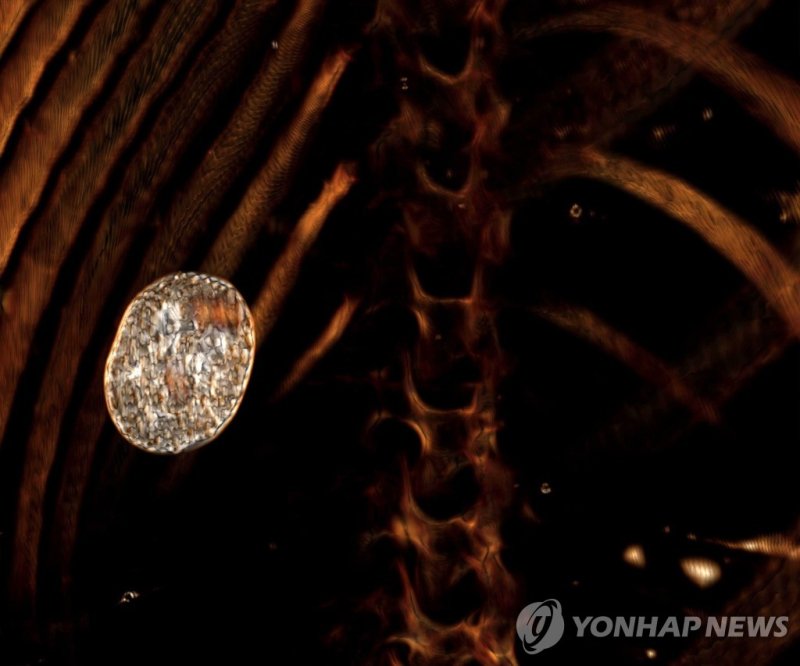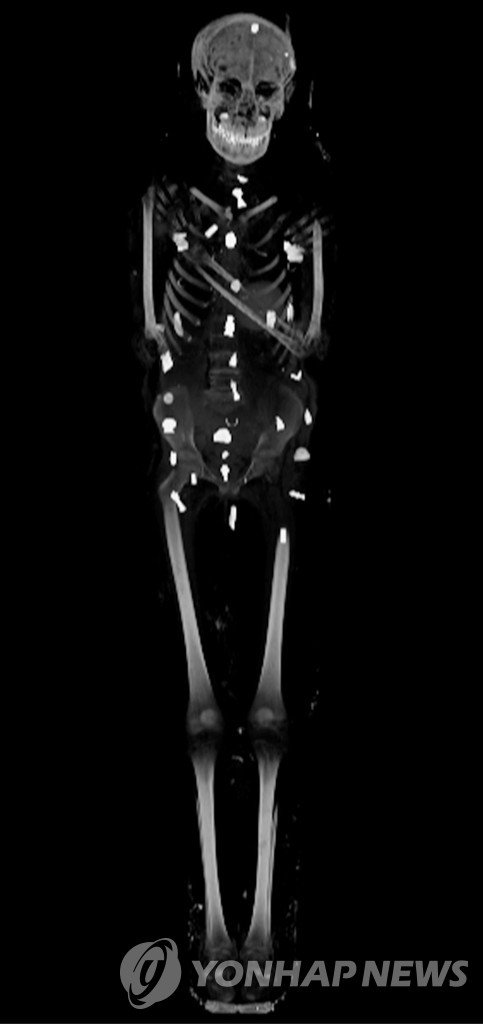황금 혀·이시스 매듭 등 부적 온몸에…"사후세계서 신체 보호"
14∼15세 계란형 얼굴…사회적 지위 높았을 듯
2천300년된 이집트 소년 미라 CT 찍어보니…부적 49개 드러나
황금 혀·이시스 매듭 등 부적 온몸에…"사후세계서 신체 보호"
14∼15세 계란형 얼굴…사회적 지위 높았을 듯

황금 소년 미라에서 발견된 부적 epa10427011 A handout photo made available 24 January 2023 by the Ministry of Tourism and Antiquities shows computed tomography (CT) scans and three-dimensional printing revealing the secrets of the 2,300 old golden boy's mummy at the Egyptian Museum. The ?golden mummy? had been stored in the basement of the Egyptian Museum in Cairo for more than a century prior to its analysis; the latter led to a scientific study published on January 24, 2023 in the journal Frontiers in Medicine by Dr. Sahar Saleem, Professor of Radiology at Cairo University, Egypt. The mummy was discovered completely wrapped in a tomb dated to the Ptolemaic Period (circa 300 BC) in Edfu, southern Egypt, in 1916; it was then moved to the Egyptian Museum's basement. Stored and left unexamined for over a century, the mummy was recently studied for the first time by radiologist Dr. Sahar Saleem, using a computed tomography machine located in the garden of the Egyptian Museum. After more than two thousand years of internment, advanced radiology, modern computer programmes, and three-dimensional printing finally revealed the identity of the mummy; Dr. Saleem revealed it to be belonging to a 15 years-old boy. Results of the analysis showed that the mummification was of significantly high quality. The process involved removing the brain through the nostril, removing the viscera through a small incision in the lower abdomen and inserting packs of resins inside the skull and body cavity. According to ancient Egyptian belief, ancient Egyptian embalmers kept the heart inside the body as it was believed to contain the thoughts and emotions of the deceased. In this case, the heart can be seen in the CT images, inside the chest cavity. The CT scans also revealed that the mummy's body was extensively decorated with 49 amulets which were beautifully tucked, in an arrangement of three columns, between the folds of the wrappings and inside the mummy?s body cavity. The amulets were of 21 different shapes inclu (서울=연합뉴스) 최재서 기자 = 2천300년 전 사망한 이집트 소년의 미라를 컴퓨터단층촬영(CT)으로 분석 결과 황금 등으로 화려하게 치장된 수십 개의 부적이 발견됐다고 25일(현지시간) 미국 CNN 방송이 보도했다.
이 '황금 소년' 미라는 기원전 332년에서 기원전 30년 사이 사용된 것으로 추정되는 공동묘지 나그 엘-하사이에서 1916년 처음 발굴됐다.
하지만 이후 오랜 기간 조사가 진행되지 않은 상태로 박물관 지하에 보관됐다. 내부를 살펴보려 미라를 풀어헤치는 것 자체로 시신이 훼손되기 때문이다.
최근 미라에 접촉하지 않고도 내부를 살펴볼 수 있는 CT 스캔 방식이 도입되며 '황금 소년'의 모습이 마침내 세상에 알려지게 됐다.
CT 촬영 결과 이 황금 미라는 총 2개의 관으로 감싸인 형태로, 안쪽 나무관에는 금박을 입힌 얼굴 무늬가 새겨진 것으로 파악됐다.
소년의 나이는 사망 당시 14∼15세, 키는 128㎝ 정도로 추정됐다. 작은 코와 좁은 턱, 계란형 얼굴을 가진 아이였다.
특히 CT 사진에서는 소년의 입과 가슴 등에서 총 21가지 모양을 가진 다양한 부적 49개가 발견됐다.
대부분 금으로 만들어졌고, 준보석이나 구운 점토, 도자기 등이 쓰인 부적도 있었다.

황금 소년 미라 CT 사진 epa10427009 A handout photo made available 24 January 2023 by the Ministry of Tourism and Antiquities shows computed tomography (CT) scans and three-dimensional printing revealing the secrets of the 2,300 old golden boy's mummy at the Egyptian Museum. The ?golden mummy? had been stored in the basement of the Egyptian Museum in Cairo for more than a century prior to its analysis; the latter led to a scientific study published on January 24, 2023 in the journal Frontiers in Medicine by Dr. Sahar Saleem, Professor of Radiology at Cairo University, Egypt. The mummy was discovered completely wrapped in a tomb dated to the Ptolemaic Period (circa 300 BC) in Edfu, southern Egypt, in 1916; it was then moved to the Egyptian Museum's basement. Stored and left unexamined for over a century, the mummy was recently studied for the first time by radiologist Dr. Sahar Saleem, using a computed tomography machine located in the garden of the Egyptian Museum. After more than two thousand years of internment, advanced radiology, modern computer programmes, and three-dimensional printing finally revealed the identity of the mummy; Dr. Saleem revealed it to be belonging to a 15 years-old boy. Results of the analysis showed that the mummification was of significantly high quality. The process involved removing the brain through the nostril, removing the viscera through a small incision in the lower abdomen and inserting packs of resins inside the skull and body cavity. According to ancient Egyptian belief, ancient Egyptian embalmers kept the heart inside the body as it was believed to contain the thoughts and emotions of the deceased. In this case, the heart can be seen in the CT images, inside the chest cavity. The CT scans also revealed that the mummy's body was extensively decorated with 49 amulets which were beautifully tucked, in an arrangement of three columns, between the folds of the wrappings and inside the mummy?s body cavity. The amulets were of 21 different shapes inclu 고대 이집트인들은 사후세계로 가려면 위험한 지하세계를 통과해야 한다고 믿었고, 부적을 통해 그 여정을 떠나는 데 도움을 주고자 했다.
카이로대 사하르 살림 교수는 소년의 몸에서 발견된 부적의 목적이 "사후세계에서 신체를 보호하고 생명력을 부여하는 것"이라고 설명했다.
그중 '황금 혀' 부적은 사후세계에서 말을 할 수 있도록 돕기 위한 것이고, '이시스 매듭' 부적은 이시스 여신의 보호를 의미한다.
망자의 심장 위치에 놓는 풍뎅이 모양의 황금 장식품 '하트 스카라베'를 비롯해 호루스의 눈, 타조 깃털, 두 손가락 등 부적도 몸 곳곳에서 찾아볼 수 있었다.
이 밖에도 소년의 발에는 관을 떠나는 데 도움을 주는 의미로 샌들이 놓여있고, 온몸은 이집트인들이 중요시했던 양치식물로 휘감겨 있다.
소년의 신원은 밝혀지지 않았으나 치아 상태와 미라의 기술 수준, 부적들에 비춰 사회적 지위가 높았음을 짐작할 수 있다고 CNN은 전했다.
이 미라는 이집트 박물관에서 CT 이미지들과 함께 전시되고 있다.
acui721@yna.co.kr
(끝)
<저작권자(c) 연합뉴스, 무단 전재-재배포 금지>
※ 저작권자 ⓒ 연합뉴스, 무단전재-재배포 금지

